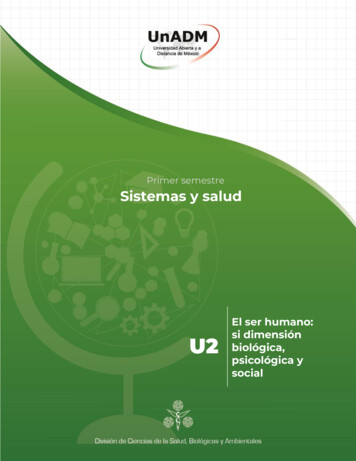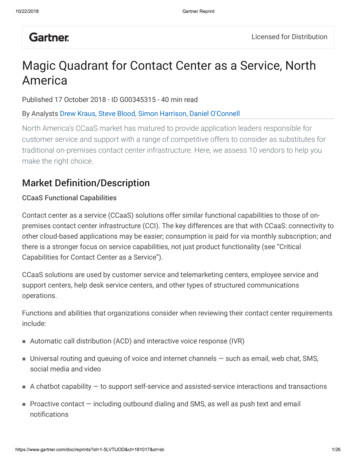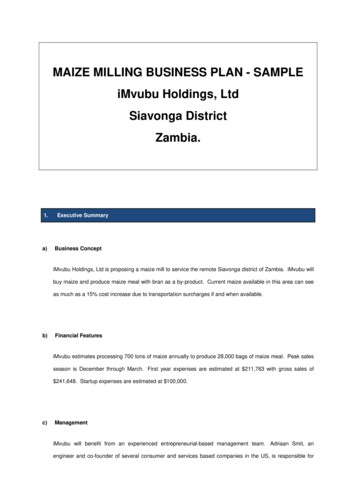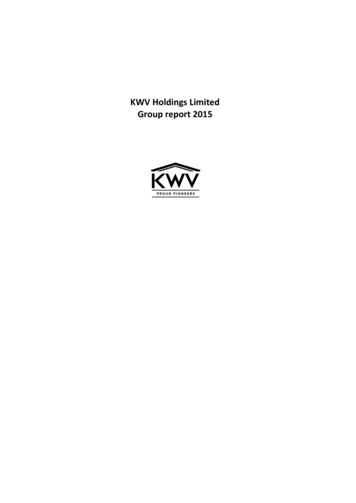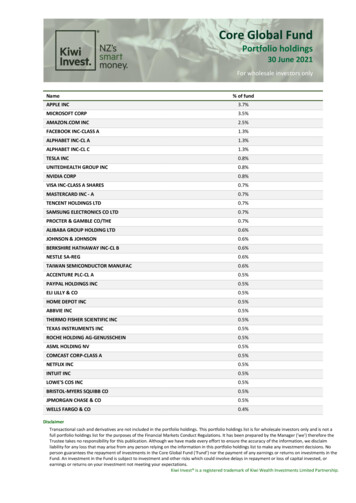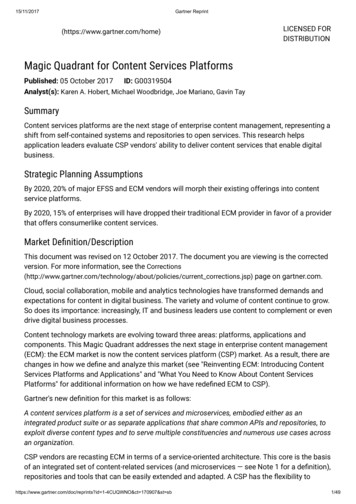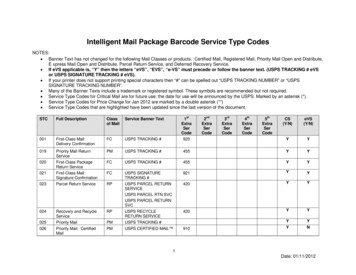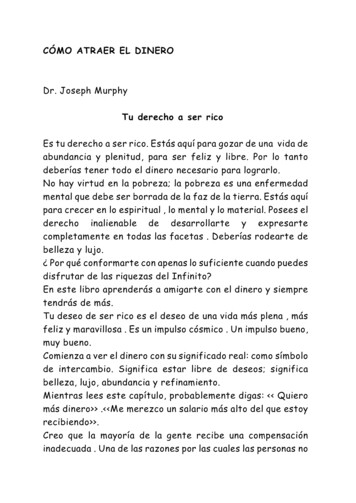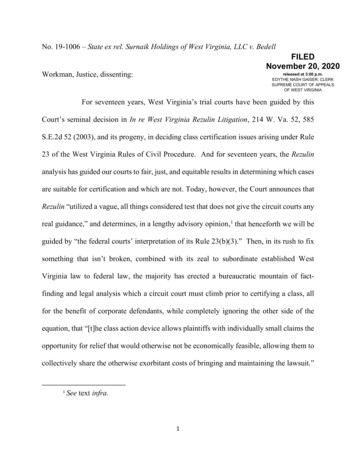
Transcription
No. 19-1006 – State ex rel. Surnaik Holdings of West Virginia, LLC v. BedellFILEDNovember 20, 2020Workman, Justice, dissenting:released at 3:00 p.m.EDYTHE NASH GAISER, CLERKSUPREME COURT OF APPEALSOF WEST VIRGINIAFor seventeen years, West Virginia’s trial courts have been guided by thisCourt’s seminal decision in In re West Virginia Rezulin Litigation, 214 W. Va. 52, 585S.E.2d 52 (2003), and its progeny, in deciding class certification issues arising under Rule23 of the West Virginia Rules of Civil Procedure. And for seventeen years, the Rezulinanalysis has guided our courts to fair, just, and equitable results in determining which casesare suitable for certification and which are not. Today, however, the Court announces thatRezulin “utilized a vague, all things considered test that does not give the circuit courts anyreal guidance,” and determines, in a lengthy advisory opinion, 1 that henceforth we will beguided by “the federal courts’ interpretation of its Rule 23(b)(3).” Then, in its rush to fixsomething that isn’t broken, combined with its zeal to subordinate established WestVirginia law to federal law, the majority has erected a bureaucratic mountain of factfinding and legal analysis which a circuit court must climb prior to certifying a class, allfor the benefit of corporate defendants, while completely ignoring the other side of theequation, that “[t]he class action device allows plaintiffs with individually small claims theopportunity for relief that would otherwise not be economically feasible, allowing them tocollectively share the otherwise exorbitant costs of bringing and maintaining the lawsuit.”1See text infra.1
Salem Int’l Univ., LLC v. Bates, 238 W. Va. 229, 237, 793 S.E.2d 879, 887 (2016)(Workman, J., concurring).I.I begin with the actual holding of this case: that “the circuit court has exceededits legitimate powers by certifying the class while failing to undertake a thorough analysisin its determination of whether the class certification requirements of Rule 23 . . . weresatisfied.” I have no quarrel with the proposition that “[b]efore certifying a class underRule 23 of the West Virginia Rules of Civil Procedure [1998], a circuit court mustdetermine that the party seeking class certification has satisfied all four prerequisitescontained in Rule 23(a) – numerosity, commonality, typicality, and adequacy ofrepresentation – and has satisfied one of the three subdivisions of Rule 23(b).” Syl. Pt. 8,in part, Rezulin, 214 W. Va. at 56, 585 S.E.2d at 56. Additionally, I agree that in makingthis determination, the court is required to undertake a “thorough analysis,” and that itsfailure to do so “amounts to clear error.” State ex rel. Chemtall Inc. v. Madden, 216 W.Va. 443, 454, 607 S.E.2d 772, 783 (2004). I part company with the majority, however, inits conclusion that the experienced circuit court judge handling this litigation did notundertake a thorough analysis of the evidence and the governing law in crafting hisdecision. The court’s certification order – 14 pages of findings of fact, conclusions of law,and a trial plan, plus 3 pages of appended material delineating the geographical area of theclass – demonstrates that the court had a comprehensive understanding of the evidence andhow it fit within the framework of a Rule 23 analysis. The only fault I can find in the order2
– and it is a fault, not a fatal flaw -- is that the court did not organize all of its findings andconclusions under specific headings: numerosity, commonality, typicality, adequaterepresentation, predominance, and superiority of the class action mechanism. Rather, itmade succinct, but not merely conclusory, findings under those headings, and thendiscussed the application of law to the facts at length in the portion of its order styled“Conclusions of Law.” 2Based upon the record before this Court, and on the factual findings andlegal conclusions set forth in the circuit court’s order, it is difficult to envision a case bettersuited for resolution pursuant to the mechanism set forth in Rule 23 of the West VirginiaRules of Civil Procedure. Respondent’s complaint alleges that in the early morning hoursof October 21, 2017, a warehouse in the 3800 block of Camden Avenue in Parkersburg,West Virginia, caught fire, and thereafter burned until October 29, 2017. The complaintfurther alleges that during this 8-day period of time, smoke and particulate matter from thefire and smoldering ruins constituted a nuisance and health hazard to residents and workers(in both private businesses and government offices) within an 8.5 mile radius of thewarehouse. In the complaint and also in his deposition testimony, Respondent also allegesThe majority does find the organization of the circuit court’s analysis to be a fatalflaw, concluding that “[a]lthough the circuit court’s order does contain a bit more analysisin the ‘Conclusions of Law’ section by intertwining the predominance and superiorityrequirements together, this discussion does not cure the defects of its initial analysis.” Thisbit of analysis to which the majority sarcastically refers is 6 pages of findings andconclusions, supported by citations of numerous legal authorities.23
that he and all other residents and workers suffered property damage in the form of smokeand particulates from the fire invading homes “at levels that interfered with the comfort,use, and enjoyment of their property,” together with inchoate damages such as annoyanceand inconvenience; and further that he and at least some other residents and workerssuffered personal injuries as well. In summary, in this case we have a large number ofplaintiffs (estimated to be 57,000), experiencing harm in different degrees, 3 arising from asingle event which took place in a defined location over a short period of time.In support of his motion for class certification, Respondent submitted experttestimony from three individuals whose credentials are not disputed. The first expertdelineated the geographical boundary of the area allegedly impacted by the emission ofsmoke and particulate matter; specifically, the class area was defined as the area withinIn this regard, the circuit court wrote that that “[b]ecause any questions relatesolely to the issues of damages, at the very least, the proposed class action should becertified on the issues of liability and causation under Rule 23(c)(4).” (Emphasis added.)Thus, all of Petitioner’s complaints that 90% of the class suffering no damages at all – ahighly misleading statement which reflects Petitioner’s apparent belief that the onlydamages recoverable in this action would be for bodily injury and/or noticeable alterationsto property – are, if not a complete red herring, certainly not a death blow to themaintenance of a class action. “‘That class members may eventually have to make anindividual showing of damages does not preclude class certification.’” Rezulin, 214 W.Va. at 72, 585 S.E.2d at 72 (citing Smith v. Behr Process Corp., 54 P.3d 665, 675 (Wash.2002)). Further, “[a] circuit court’s consideration of a motion for class certification shouldnot become a mini-trial on the merits of the parties’ contentions[,]” Rezulin, 214 W. Va.at 63, 585 S.E.2d at 63, which is exactly what Petitioner seeks and what the majority hasgifted it.34
which individual would have had exposure within a 24-hour average of at least 3micrograms per cubic meter of fine particles less than 2.5 microns in size. The secondexpert did disbursement modeling to draw the isopleths 4 within which individuals wouldhave had exposure at this 3 micrograms per cubic meter level. Finally, the third expert, aphysician, gave evidence tending to show that this level of exposure to particulate matterincreased the risk of various health problems ranging in severity from discomfort to death.Ultimately, the circuit court certified a class consisting of all residents andbusinesses within an 8.5 mile radius of Petitioner’s warehouse. The court concluded thatthere weremany common questions of law and fact, including to nameonly a few of the most important: questions concerningindustry standards for fire protection systems; questionsrelating to what was stored in the warehouse; how the decisionnot to maintain the fire protection system [was] made; whomade it; which of those chemicals burned; what thedecomposition products of the waste chemicals was; the areaof dispersion of smoke and particulate matter; and the potentialfor harm from contact, inhalation, or ingestion of the smokeand particulate matter.The court also concluded that “[b]ecause any individual questions relate solely to the issuesof damages, at the very least, the proposed class action should be certified on the issues ofliability and causation under Rule 23(c)(4).”An isopleth is defined as a line on a map connecting points having equalincidence of a specified meteorological feature.45
Reviewing the circuit court’s common questions of law and fact, it is hard tofathom the majority’s dismissive conclusion that the court’s order is “woefully inadequate”to demonstrate that those common questions predominate. In a recent case, we affirmedthe guidance set forth in Rezulin that “[i]n deciding predominance, the ‘central question[is] whether “adjudication of the common issues in the particular suit has important anddesirable advantages of judicial economy compared to all other issues, or when viewed bythemselves.” 2 Newberg on Class Actions, 4th Ed., § 4.25 at 174.’” State ex rel. U-Haul Co.of W. Va. v. Tabit, No. 17-1052, 2018 WL 2304282, at *8 (W. Va. May 21, 2018)(memorandum decision) (citing Rezulin, 214 W. Va. at 72, 585 S.E.2d at 72)). We wenton to explain that,[t]he predominance requirement does not demand thatcommon issues be dispositive, or even determinative; it is nota comparison of the amount of court time needed to adjudicatecommon issues versus individual issues; nor is it a scalebalancing test of the number of issues suitable for eithercommon or individual treatment. 2 Newberg on Class Actions,4th Ed., § 4.25 at 169-173. Rather, ‘[a] single common issuemay be the overriding one in the litigation, despite the fact thatthe suit also entails numerous remaining individual questions.’Id. at 172.U-Haul., 2018 WL 2304282, at *9 (citation omitted). In the instant case, can there be anyserious question that the predominant issues are those enumerated by the circuit court?And as a corollary proposition, can there be any serious question that thereafter, the courthas a “variety of procedural options under Rule 23(c) and (d), to reduce the burden of6
resolving individual damage issues, including bifurcated trials, use of subclasses ormasters, pilot or test cases with selected class members, or even class decertification afterliability is determined[]”? U-Haul., 2018 WL 2304282, at *9. 5Even more difficult to fathom is the majority’s conclusion that the circuitcourt’s finding with respect to superiority, Rule 23(b)(3), is “conclusory in that it listedcases where class certification was found to be appropriate in mass accident cases withoutgiving any explanation as to why those particular cases fit the facts of this matter.” Again,the majority is parsing the court’s order paragraph by paragraph, without considering itsfindings and conclusions as an integrated whole. With respect to superiority, the courtstressed the fact that “the damages suffered by most class members are too small to warrantthe associated costs of pursuing such cases, such as basic filing fees, deposition fees,attorney time in processing, and expert witness fees.” And again, inasmuch as the courtcertified a class only as to liability and causation – essentially, was Petitioner negligent orreckless, and did that negligence or recklessness cause the warehouse fire which belchedsmoke and particulates for 8 days over an 8.5 mile radius – I am hard pressed to come upwith any rationale which could possibly support the conclusion that a better way to handlethe matter would be to require anyone claiming to have suffered injury and damage to filean individual lawsuit. Even accepting Petitioner’s claim that only 10% of those within the5See supra note 3.7
8.5 mile radius suffered actual harm, 6 the result would be 5,700 individual lawsuits –enough to force the judicial system to its knees, notwithstanding the 1,140,000.00 in filingfees that would be generated.In summary, the majority’s decision in this case exalts form over substance,and requires that a circuit court’s order granting class certification must contain far morethan the “detailed and specific showing” previously deemed sufficient. E.g., State ex rel.Municipal Water Works v. Swope, 242 W. Va. 258, 267-68, 835 S.E.2d 122, 131-32 (2019).Rather, the order will have to contain a level of claim-by-claim, issue-by-issue, defenseby-defense analysis somewhere between a blue book essay and a law review article inlength. Here, where the class parameters have been so well defined by the testimony ofexpert witnesses, and the analysis of the circuit court is so clear and so evidently correct,one can only read the majority opinion as a result-driven attempt to steer the circuit court,on remand, in Getting to No.The majority follows Petitioner down this particular rabbit hole, criticizing thecircuit court’s finding that “owning or residing in a house that is invaded by noxious orharmful levels of smoke negligently released from a fire is a cognizable injury [to all classmembers],” by setting up a straw man argument as to whether the essential elements of thevarious causes of action alleged in the complaint “are capable of individualized or evengeneralized proof.” This is a merits question more properly addressed on motion forsummary judgment; a certification inquiry under Rule 23 does not require plaintiff to provehis or her case, only to establish that the issues fall within the framework established insubsections (a) and (b) of the rule.68
II.Having expressed my disagreement with the majority’s holding, I now turnto the lengthy advisory opinion 7 which precedes the relatively brief discussion of the actualissue in this case. Petitioner raised five issues in its brief: that common issues do notpredominate in this case because only 10% of the class is likely to have been injured; thatmass accident and toxic tort cases are inappropriate for class adjudication; that plaintiffcannot satisfy the certification requirements of standing and typicality because he concedesthat he has not suffered any property damage; that the class members are not readilyidentifiable by reference to objective criteria; and that the circuit court failed to conduct athorough analysis of the Rule 23 factors. In this latter regard, Petitioner’s entire argumentMore than half of the majority’s “Discussion” could be classified either as (a) dicta,(b) an advisory opinion, or (c) the use of a backhoe to dig a one inch hole. This Court hasdefined dicta as language “which, by definition, is . . . unnecessary to the decision in thecase and therefore not precedential. Black’s Law Dictionary 1100 (7th ed. 1999).” Stateex rel. Med. Assurance of W. Va., Inc. v. Recht, 213 W. Va. 457, 471, 583 S.E.2d 80, 94(2003). With respect to advisory opinions, we have held that “the requirement of ajusticiable controversy and the prohibition against advisory opinions are two sides of thesame coin. We explained this in Syllabus Point 2 of Harshbarger v. Gainer [184 W. Va.656, 659, 403 S.E.2d 399, 402 (1991)] when we held that ‘[c]ourts are not constituted forthe purpose of making advisory decrees or resolving academic disputes. The pleadings andevidence must present a claim of legal right asserted by one party and denied by theother[.]’” State ex rel. Perdue v. McCuskey, 242 W. Va. 474, 478, 836 S.E.2d 441, 445(2019). I have chosen to refer to the scholarly exposition in this case as an advisoryopinion, since the majority is quite clearly attempting to advise the circuit court withrespect to how it should resolve an issue that has not actually been raised by anyone otherthan the majority: the sufficiency of the circuit court’s order with respect to the question ofpredominance. See text infra.79
was that the court’s analysis of typicality and ascertainability 8 was insufficient, not itsanalysis of predominance. Although I believe that the first four of these issues are withoutmerit, based on my review of the evidence contained in the appendix record, this is of nomoment; the fact is that these issues all became moot when the majority decided the caseon the ground that the circuit court’s order was insufficient to demonstrate the “thoroughanalysis” required by our case law, and specifically with respect to the circuit court’sfindings of predominance and superiority.In this regard, the majority could have cited the comprehensive discussion ofpredominance set forth in Rezulin and its progeny, and rested its decision thereon.‘A conclusion on the issue of predominance requires anevaluation of the legal issues and the proof needed to establishthem. As a matter of efficient judicial administration, the goalis to save time and money for the parties and the pubic and topromise consistent decisions for people with similar claims.’In the Matter of Cadillac V8-6-4 Class Action, 93 N.J. 412,430, 461 S.E.2d 736, 745 (1983). The predominancerequirement is not a rigid test, but rather contemplates a reviewof many factors, the central question being whether‘adjudication of the common issues in the particular suit hasimportant and desirable advantages of judicial economyInterestingly, this word is not found in either the text of Rule 23 or in any of thisCourt’s class action cases. Rather, it is a formulation discussed in some federal cases,describing the unremarkable concept that a class and its members must be readilyidentifiable with reference to objective criteria, “without extensive and individualized factfinding or ‘mini-trials[.]’” Marcus v. BMW of N. Am., LLC, 687 F.3d 583, 592-93 (3rd Cir.2012) (citation omitted). In the instant case, the testimony of Respondent’s experts mostcertainly met any requirement of ascertainability. See text supra.810
compared to all other issues, or when viewed by themselves.’2 Newberg on Class Actions, 4th Ed., § 4:25 at 174.Rezulin, 214 W. Va. at 72, 585 S.E.2d at 72; see also U-Haul, 2018 WL 2304282, at *8(“In deciding predominance, the ‘central question [is] whether ‘adjudication of thecommon issues in the particular suit has important and desirable advantages of judicialeconomy compared to all other issues, or when viewed by themselves.’”) (citation omitted).Undaunted by the fact that Petitioner did not argue insufficiency of the circuitcourt’s analysis of predominance (it simply claimed that the court’s decision was erroneousbecause the existence or extent of individual damages would vary), or the fact that the issueof the sufficiency of the court’s analysis could easily be resolved under existing WestVirginia law, the majority devotes pages of text to what is termed a “general review” offederal cases dealing with predominance. The majority notes with approval those casesthat require the lower court to perform a “rigorous analysis,” or even a “more rigorousanalysis” of class certification motions, as opposed to this Court’s “thorough analysis”standard. 9 (Emphasis added.) The majority further acknowledges the current trend inIn his concurring opinion in State ex rel. Chemtall Inc. v. Madden, 216 W. Va.443, 458, 607 S.E.2d 772, 787 (2004), then-Justice Starcher commented on the federalcourts’ seeming hostility toward class action lawsuits:9In the instant case, the defendants argued that a ‘class action. . . may only be certified if the trial court is satisfied, after arigorous analysis, that the prerequisites of Rule 23(a) havebeen satisfied.’ General Telephone Co. of Southwest v. Falcon,457 U.S. 147, 161, 102 S.Ct. 2364, 2372, 72 L.Ed.2d 74011
federal courts “toward heightening plaintiffs’ burden . . . [which] has decidedly outpacedconcern over providing a mechanism for litigating low-value claims.” 10 There is noapparent reason given for the majority’s clear preference for the anti-plaintiff positionespoused by the federal courts cited in its opinion; and whatever the reason, it seems clearthat the Court is signaling a retreat from what the United States Supreme Court once termedWest Virginia’s “declar[ation of] independence from federal courts’ interpretation of the(1982) (emphasis added). As the majority opinion suggests,most federal courts have blithely accepted this argument andrequire a party seeking class action certification to endure a‘rigorous’ analysis of their class certification evidence by thetrial court.After carefully reading Rule 23 of our Rules of CivilProcedure, and reading the Rules as a whole, neither I nor mycolleagues can find anything that requires a party to submit anymotion to a ‘rigorous’ analysis by the trial court. Use of theterm ‘rigorous’ suggests that a trial judge must exercise‘harshness, rigidity, inflexibility,’ or be ‘severely exact oraccurate; . . . stern . . . hard, inflexible, stiff, unyielding.’Frankly, it is difficult to determine how a litigant could achievea ‘just, speedy and inexpensive’ resolution of a dispute whenthe trial judge, usually at the initial, pre-trial stages of the case,is being harsh, inflexible, exacting and unyielding inconsidering the parties’ motions.Chemtall, 216 W. Va. at 458, 607 S.E.2d at 787 (footnote omitted).Ellen Meriwether, The Fiftieth Anniversary of the Rule 23 Amendments: AreClass Actions on the Precipice?, 30 Antitrust, 23, 24 (Spring 2016).1012
Federal Rules – and particularly of Rule 23.” Smith v. Bayer Corp., 564 U.S. 299, 310(2011).I acknowledge that federal law is “the supreme law of the land,” WestVirginia Constitution, article I, section 1, in all matters involving the interpretation of theUnited States Constitution and laws enacted by Congress. Further, I agree with themajority that review of federal cases can be beneficial in analyzing issues that arise underthe West Virginia Rules of Civil Procedure, since our rules are largely consonant with(although not identical to, as the majority intimates) their federal counterparts. However,I am not required to, nor will I, march in lockstep with federal decisions that I believe erectbarriers to West Virginia citizens’ right to seek redress for injuries in the courts of thisState, pursuant to the laws of this State. As noted above, the majority acknowledges theexistence of a “current trend toward heightening plaintiffs’ burden[,]” and my question isthis: why does the majority apparently view this as a positive development in the federallaw, and seek to bring West Virginia into line with this view?In this latter regard, the majority opinion intimates, although it does notdirectly state, that in State ex rel. West Virginia University Hospitals, Inc. v. Gaujot, 242W. Va. 54, 829 S.E.2d 54 (2019), a case in which two members of this Court did notparticipate, we effectively adopted federal analytical standards in class certification casesin lieu of the standards set in our own precedents. If this reading of Gaujot is accurate, then13
the Court acted under cover of darkness; although several of the syllabus points in the casecite federal precedents, the concepts have long been established in our own case law. Forexample, although the Court in Gaujot cited only federal cases to support the legalprinciples set forth in syllabus points five, six and seven – all having to do with the limitedand coincidental scope of merits issues in determining class certification questions – theCourt admitted in the text of the opinion that “[o]ur prior decisions bear that out],]” 242W. Va. at 63, 829 S.E.2d at 63 (citing Chemtall, 216 W. Va. at 455, 607 S.E.2d at 784;Ways v. Imation Enterprises Corp., 214 W. Va. 305, 314, 589 S.E.2d 36, 45 (2003)).In summary, although the majority’s lengthy exposition of federal law makesfor interesting reading, most of it is wholly unnecessary to the decision in this case.Further, to the extent that the majority is attempting to sub silentio overrule any or all ofthe precepts set forth in Rezulin and its progeny, in order to bring West Virginia in linewith the “current [federal] trend toward heightening plaintiffs’ burden[,]” 11 I stronglyobject both to the majority’s tactics and to its intentions. This Court’s precedents havestood the test of time and guided our circuit courts, as well as this Court on appellatereview, to results that are fair to all parties.11See supra page 12 & note 10.14
Indeed, our precedents guided the court below – a very experienced jurist -to a fair and legally sustainable result: permitting a class action suit to go forward on theissues of liability and causation, in a case arising from a single event which took place in adefined location over a short period of time, affecting everyone who lived and/or workedwithin the defined location. The majority reverses this decision, demanding that the courtfurther explain, at great length and in excruciating detail, how these issues could be said topredominate over issues of damages; and that the court further explain superiority, i.e., howclass certification could possibly be a better framework for resolution of 57,000 cases (oreven 5,700 cases) than requiring each plaintiff to file an individual lawsuit.The majority opinion is flatly wrong in its analysis of the facts, createsunnecessary delay in this case, and portends a sea change in our approach to class actioncases – a change for the worse. Accordingly, I dissent.15
State ex rel. Surnaik Holdings of West Virginia, LLC v. Bedell. Workman, Justice, dissenting: For seventeen years, West Virginia's trial courts have been guided by this Court's seminal decision in In re West Virginia Rezulin Litigation, 214 W. Va. 52, 585 S.E.2d 52 (2003), and its progeny, in deciding class certification issues arising .
